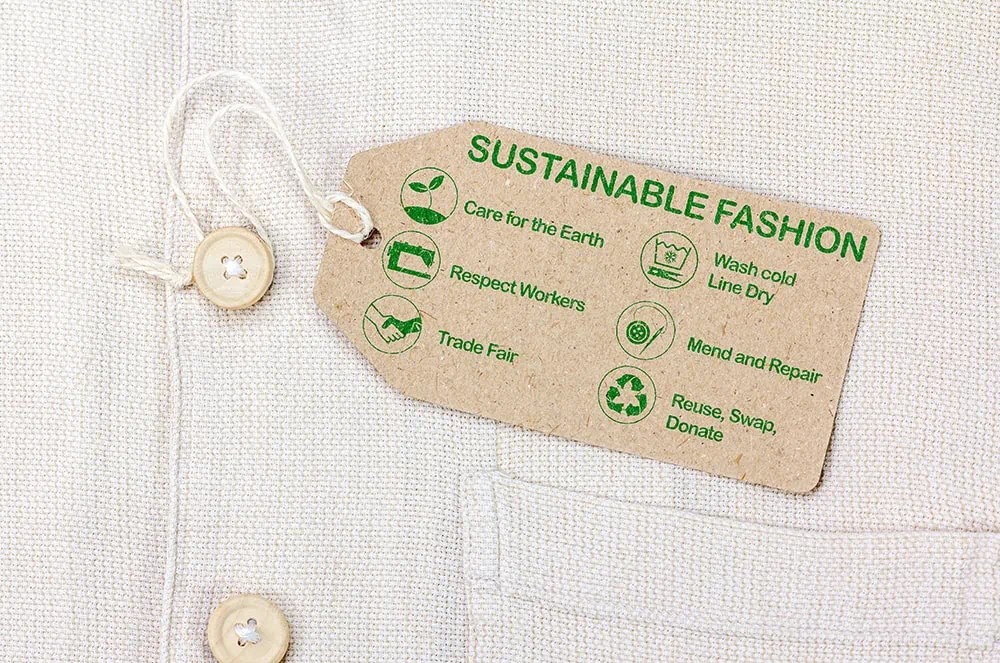
Why saving the planet makes sense for clothing and accessory brands.
Pressure is building on the fashion industry to address its sustainability record. New regulations in key territories mark a serious shift in governmental attitudes. In the words of the UK Environmental Audit Commission (EAC), “The fashion industry has marked its own homework for too long.”
In terms of both environmental damage and worker exploitation, there is much work to do. But for fashion brands with genuine intentions, this is an opportunity to put significant distance between themselves and the murky world of fast fashion.
In this article we look at the reasons for the new regulations, the actions fashion brands need to take in response and the benefits of these actions for the planet, its people and the fashion business.
Why Are Legislators Picking on Fashion?
From design to disposal, the fashion industry is one of the leading perpetrators of environmental and human damage. Textile production contributes more to climate change than international aviation and shipping combined. According to Statista, over four billion pieces of apparel are consumed every year in the UK alone*. That figure has risen by nearly half a billion in the last 10 years and is forecast to go on rising. This rapid increase in consumption of clothes has been met through destructive farming, use of harmful synthetic materials, high energy consumption, exploitation of cheap labour and polluting production processes.
At the other end of the line, it has caused obscene levels of waste. Synthetic fibres have been found in the deep sea, in Arctic sea ice, in fish and shellfish. According to a report by Greenpeace, around 300,000 items of clothing bought in the UK are burned or sent to landfill every year. In Europe the average consumer throws away 11kg of textiles per year. Stella McCartney has spoken out about the “equivalent of one garbage truck of textiles burned or landfilled every second” on a global scale, and the fact that “less than 1% of the material used to produce clothing is recycled into new clothing, meaning 99% of all textiles is waste”.
The EU has graded textile consumption as having the fourth highest impact on the environment, after food, housing and mobility. That impact comes in the form of pressure on water and land use, in which the textile industry is in the top three, and resource use and greenhouse gas emissions, in which it is in the top five.
After years of insufficient self-regulation, and with growing public concern over climate change and humanitarian issues, legislators have decided that it’s time to enshrine the changes required for sustainable fashion into law.
What Are the New Regulations?
The EU Green Deal, which was approved in 2020, includes the Sustainable Products Initiative (SPI), a regulation aimed at improving product circularity, energy performance and other environmental sustainability aspects. The SPI is scheduled to come into force in 2024 but brands will need to start taking action this year.
France is leading the way with a new regulation requiring every garment sold within its borders to have a label detailing its precise climate impact. This must be implemented by the end of 2023. Under the EU Green Deal, this will be a requirement throughout Europe by 2026.
In New York State, the new Fashion Sustainability and Social Accountability Act (Fashion Act) will be the first regulation of its kind in the US to hold fashion brands accountable for their environmental and social impacts. Brands will be obliged to disclose information on their supply chains, including carbon emissions and labour standards. Those falling short of the regulatory standards will be forced to make changes or face fines and likely damage to their reputation.
On the horizon in the US is the Fabric Act, which incorporates five processes for improving the working conditions of garment workers. California has already passed its own Garment Worker Protection Act.
As yet there is no specific regulation in the UK holding fashion brands accountable for their environmental impact, but the 10-year Fashion Industry Sustainable Change Programme, launched in 2022 with the goal of creating a world-leading circular economy for fashion and textiles in the UK, is an indication that legislation will soon be on the way. Until then, UK brands will still be affected by legislation in other parts of the global market, both through overseas sales and their supply chain.
What Are the Key Elements of Sustainable Fashion?
Design
Research has shown that 80% of a clothing product’s impact on the environment throughout its lifecycle is determined at the design stage. Fashion designers are being set goals by the EU to ensure that by 2030 all textile products are:
- Durable, repairable and recyclable
- Largely made from recycled fibres
- Free from hazardous substances
- Produced in ways that respect social rights
As the EAC recognises, “UK designers are already taking a lead on sustainable fashion” but they need the support of Government, perhaps through taxation, to suppress competition from unethical fashion companies.
Workers’ Rights
Intrinsic to the EU Strategy for Sustainable and Circular Textiles is the Better Work Programme, through which the European Commission seeks to improve working conditions and ensure international labour standards are applied in third partner countries.
Gender equality is a particular area of focus, with 75% of the world’s garment workers being women. Child labour is another area of concern. The rapid rise in garment sales globally has seen a concurrent rise in people (including children) being forced to work long hours for low wages, with no breaks or sick pay – conditions that amount to modern slavery.
Fashion brands are bound by the Modern Slavery Act to:
- Take action to identify, prevent and mitigate modern slavery in operations and supply chains
- Publish an annual statement to report on these actions within six months of the company’s financial year-end
Consumption and Emissions
The resources consumed by fashion brands can be broken down into three categories: land and water used to grow textile crops such as cotton; harmful substances such as synthetics and chemicals used in garment production; and the energy consumed and greenhouse gases emitted throughout the supply chain, in farming, transportation, manufacture, fashion fulfilment etc.
Fashion brands will be required to step up their due diligence in order to address all these links in the chain, to measure and report with complete transparency and to take action to reduce consumption and emissions wherever possible.
Packaging
Packaging is a necessity in fashion and for luxury brands it forms a key part of the customer experience. However, brands are being required to give more thought to where their packaging comes from and where it ends up.
The EU is planning to revise its legislation on packaging and packaging waste to enforce three important objectives:
- To reduce packaging waste by restricting unnecessary packaging and promoting reusable packaging solutions.
- To promote high quality recycling so that all packaging is recyclable in an economically viable way.
- To reduce the consumption of natural resources (e.g. trees) by creating a cost-effective market for recycled natural materials and recycled plastics, and enforcing it with mandatory targets.

Circularity
One way to improve all the above conditions is to increase the longevity of garments, so that a truckload of textiles is not burned or landfilled every second. Fewer clothes of higher quality is the simple equation, and one that plays to the strengths of high fashion brands.
However, fashion is, by definition, transient and styles come and go with high frequency, so there is also an obligation on brands to consider the after-life of their garments. Can they be recycled, repaired, repurposed or even resold? If there are customers who like to “wear once and throw away”, can they be encouraged to return that one-off party dress for someone else to enjoy?
We are seeing a rise in second-hand shopping and fashion renting, driven partly by inflation but also by rising consumer awareness and demand for sustainability in the products they choose. MORI is one brand that is already facilitating the reuse of its clothing. Through its Kindness Project it encourages customers to return their preloved or unused baby clothes in return for a voucher. The clothes are then donated to the charity Little Village, which makes sure they reach those in need.
The Benefit of Sustainability Action for Fashion Brands
Stepping up your due diligence on labour standards, monitoring the energy consumption in your supply chain or running recycling programmes like MORI’s Kindness Project all involve a cost, which may cause some businesses to hesitate. But moving your processes towards greater sustainability actually offers significant business opportunities.
For example, redesigning your packaging to be less wasteful and to make creative use of recycled and recyclable materials can yield big savings. At ILG we’ve worked with many of our customers to move to more sustainable packaging solutions and have seen the efficiencies that result.
Another of our valued customers, With Nothing Underneath, has built its brand on a sustainable business model and is now a certified B Corp. That such an environment-conscious company should choose ILG as its fulfilment partner is testament to our own commitment to sustainability. Packaging is just one aspect. Our warehouses and offices are optimised for energy efficiency and minimum waste and our logistics are calculated with fuel consumption in mind. These are two examples of how efficiency yields both cost savings and environmental benefits.
The incentive, then, is there for all fashion brands to put sustainability front and centre of their business strategy. By teaming up with like-minded partners, the fashion industry has the power to make a big impact for a better world.
Find out how we can be a part of your sustainability journey and get in touch today.
Your Details
More insights >
The ILG Awards: The Winners are Announced
This weekend we gathered at the beautiful East Sussex National for the annual ILG Awards for Excellence to celebrate our wonderful colleagues and teams here.
How to Make Your Order Fulfilment More Sustainable
As brands become increasingly dedicated to operating sustainably, it’s vital that their supply chain partners are equally environmentally conscious to create an aligned vision for their customers.

